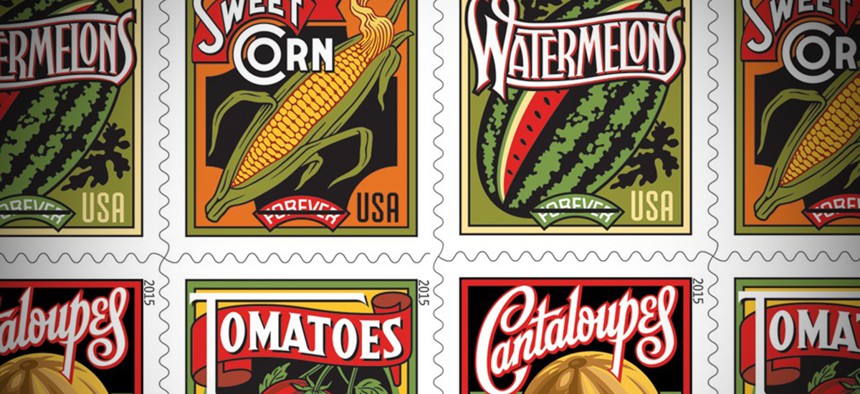
USPS
Can Design Help the USPS Make Stamps Popular Again?
The Postal Service's new Forever stamp series, 'Summer Harvest,' targets two kinds of audiences: foodies and nostalgics.
In 1967, the United States Postal Service issued a new five-cent postage stamp to celebrate Henry David Thoreau’s 150th birthday. The stamp proved exceedingly popular, but not for the reasons the USPS might have guessed: The scraggly-bearded portrait of Thoreau by Leonard Baskin became a generational emblem among members of the counterculture, who identified with Thoreau as a tax resistor, abolitionist, and naturalist. The stamp’s success, meanwhile, proved that nontraditional stamp designs could help the Postal Service connect with nontraditional audiences, especially among the nation’s youth.
After 1971, when the USPS became an independent agency of the federal government, stamps became a vital revenue source. They were also the public face of the agency, and to broaden their appeal the USPS and the Citizens Stamp Advisory Committee (CSAS) began to work on stamps that would attract not just philatelists but everyday shoppers. In a new attempt to engage a population that prefers email to snail mail, the USPS is hoping to continue this trend by selling stamps that reflect the sender’s personal allegiances and resonate with their sensibilities.
Earlier this month, the agency issued a new booklet of produce-themed stamps titled “Summer Harvest.” Designed and illustrated by the veteran illustrative letterer and typographer Michael Doret, who drew upon old fruit-and-vegetable-box labels for inspiration, the stamps seem to reflect the country’s renewed interest in organic and locally sourced food.
Antonio Alcalá, the art director at CSAS, said the group had two main audiences in mind when designing the new Forever stamps: foodies, and nostalgics. The stamps’ decorative lettering and stylized images of watermelon, cantaloupe, sweet corn, and tomatoes seem aimed at the stereotypical modern yuppie, who listens to records on vinyl, visits the local farmer’s market, shops for antiques, and might even occasionally forgo the ease of Gmail or Facebook in favor of writing and mailing a handwritten letter.
One of the challenges with producing stamps that capture a moment is that producing them is rarely a speedy process. The personnel on the committees change periodically, and the comments that come back from are sometimes arcane. In the case of the “Summer Harvest” stamps, it took almost 12 years for them to get from the drawing board to the post office. “I went through literally dozens of changes on this recent set before we settled on the approved designs,” says Doret. During the first round in 2002, he recalls there was a lot of back and forth suggesting various fruits or vegetables, then questioning what was the definition of “fruit,” then questioning whether these were specifically "American." Even after his designs were accepted it still took about three years to get from refining the subject, artwork, and lettering to printing and issuance.
This isn’t the first time the USPS has tried something new. In 1987, it commissioned the caricaturist Al Hirschfeld to design a collection of five stamps, called “Comedians by Hirschfeld,” that were eventually released in 1991. Rather than the neutral portraiture typically used on commemorative stamps, his artwork introduced wit and humor to a serious and typically staid form. Hirschfeld became the first artist in American history to have his signature on a stamp booklet—not even Norman Rockwell had his name on the 1960 Boy Scouts stamp or the 1972 Tom Sawyer stamp he designed. The goofy personalities of the eight caricatured comedians (including Laurel & Hardy, Abbot & Costello, and Fanny Brice) elicited “chuckles from the letter-writing public,” according to a 1991 article in The New York Times. By leaving its stuffy, disconnected traditions behind, the USPS had successfully tapped into the irreverent heart of pop culture.
Other recent Forever stamps have featured images of Elvis Presley, Maya Angelou, Batman, vintage roses, the Battle of 1812, and ferns. Last year, the “Farmers Market” series even celebrated American produce in the same way the “Summer Harvest” stamps do, although with a more traditional design. While the quality and variety of stamp designs has increased, 7.3 billion fewer pieces of mail are sent annually in the U.S. since “Comedians by Hirschfeld” revitalized the USPS’s public image. The agency loses billions of dollars every year, and it’s unlikely that a vintage-inspired set of stamps featuring crops can do much to change that, however visually striking they might be.
But the USPS’s attempts to tap into the zeitgeist deserve credit, and the artists, designers, and art directors behind U.S. postage stamps take extraordinary pride in creating them. “It's difficult to describe the thrill,” says Doret, “of finding out that something into which one had invested so much time and love has now suddenly come back to life.”






